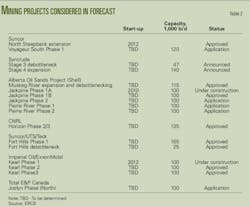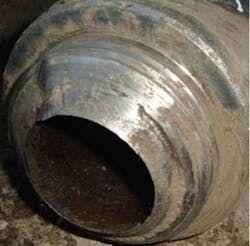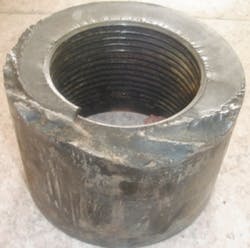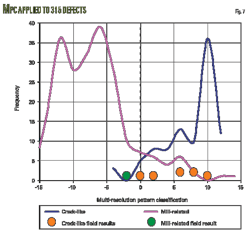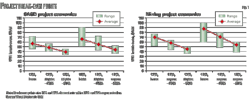A statistic analysis found that drillstring failures in Tarim oil field were related to the difference between specifications and working conditions.
The analysis documented the drillstring failures from January 2005 to March 2006.
During this time, Tarim oil field had 36 failures in 2005 and 21 from January to March 2006. These failures caused extensive lost time for fishing the broken strings and the loss of several holes.
References 1-3 provide information on some drillstring failures used in this statistical analysis.
2005 failure
The 36 failures in 2005 (Fig. 1) resulted in 3,739 hr of lost time. The failures break down as follows:
• 38.9% from 14 drilling jar fractures.
• 25% from nine drill collar fractures.
• 19.4% from seven drilling stabilizer fractures.
• 8.3% from three heavy wall pipe and drill pipe fractures.
The fractures in four of the 120.7 mm (43⁄4 in.) drill collars were at the pin's last engaged thread. Three 158.8 mm (61⁄4 in.) drill collars broke at the box and one broke at the pin. The one 203.2 mm (8 in.) drill collar failure was at the pin's last engaged thread.
In the drilling stabilizers, all fractures were at the pin's last engaged thread. Four of the failures were in the 311.2 mm (121⁄4 in.) stabilizers and one each in the 165.1 (61⁄2 in.), 406.4 mm (16 in.), and 444.5 mm (171⁄2 in.) stabilizers.
The drilling jar failures were in four 203.2 mm (8 in.) jars and three 158.8 mm (61⁄4 in.) jars with two failures at the box of the two outer canisters. The other fractures were along the length of two 228.6 mm (9 in.) jars, one 120.7 mm (43⁄4 in.) jar, and one 279.4 mm (11 in.) shock absorber.
2006 failures
Fig. 2 shows the failures from January to March 2006. These include:
• 76.2% from 16 drill collar failures.
• 14.3% from three drilling jar failures.
• 9.4% from two drill pipe failures.
Seven of the 120.7 mm (43⁄4 in.) drill collars broke at the pin's last engaged thread (Fig.3). Six 158.8 mm (61⁄4 in.) drill collars broke at the box and the failures were 102-110 mm from the box seal shoulder (Fig.4). One 203.2 mm (8 in.) collar broke at the pin's last engaged thread and another one broke at the box. One 104.8 mm (41⁄8 in.) drill collar broke at the pin.
In Well Milan 1 (photo on the left), the fracture failure in a 120.7 mm (43⁄4 in.) drill collar is in the pin's last engaged thread (Fig. 3). During January-March 2006, six 158.8 mm (61⁄4 in.) drill collars broke at the box (photo on the right). The fractures were 102-110 mm from the box seal shoulder, as seen in this failure from Well Gucheng 4 (Fig. 4). |
Fig. 3 shows a fracture due to over torsion. In Fig. 4, the fracture is from a fatigue fracture with the crack originating from the bottom thread.
The IDs of the drill collars were 57.2 mm (21⁄4 in.) in the 120.7-mm collars, and 71.4 mm (213⁄16 in.) in the 158.8 mm collars. The OD of 158.8 collars ranged from 153 mm to 160 mm. All failed drill collars had no stress decentralization grooves.
Failure causes
Bend, torsion, and impact fatigue loads during drilling cause fatigue cracks to grow easily. Fatigue fractures will occur once cracks extend to a certain size.
The wells in Tarim oil field are deep, and the field has complex geology. These factors contribute to difficult drilling conditions. During drilling, frequent bit bouncing and jumping will cause fatigue failures.
Doglegs in wells caused the drillstring to bear extra bending load that causes drill pipe to crack or fracture.4 5 Three drill pipe joints leaked because of fatigue cracks at a 500 m depth where the dogleg was 3.7°/30 m in Well LG42. Another 15 joints of drill pipe leaked because of fatigue cracks at 1,870-930 m where the dogleg was 6.5°/30 m in Well LG13 (Fig. 5).
Another reason for some of the failures was large-size polycrystalline-diamond compact (PDC) bits that increase torsion load on the drillstring.
The drilling program used shock absorbers in 54 wells in 2005. Four of the drillstrings with 406.4 mm (16 in.) PDC bits had fracture failures. Bit bouncing and jumping added extra loads on the drillstring resulting in severe service conditions.6
Three examples of these failures are:
1. In Well Q 601, the rotary table suddenly reversed because of bit bouncing and jumping, thereby breaking two pins in the corner of the rotary table.
2. In Well YL 101, five drillstring elements broke because of bit bouncing and jumping while drilling with a 444.5 mm (171⁄2 in.) PDC bit, resulting in four drillstring elements having cracks.
3. One joint of 139.7 mm (5.5 in.) S135 drill pipe broke in Well Q 601 well because of the large size PDC bit bouncing and jumping.
Fast rotation speed can increase the force away from the axes of the drillstring and result in extra bend stress borne by the drillstring. This can cause strong torsion and shock loads that damage drillstrings. High-inertia torque and kinetic energy can cause abnormal torque borne by the drillstring in the case of a bit bouncing and jumping.
Fast rotation speed also can increase the total stress borne by the drillstring, resulting in the initiation and spreading of cracks.
Statistical data show that failures increase with rotational speed. For example, in wells LG 802, HD 1-28, and LN 621 rotary table speeds were 110, 100-120, and 120 rpm, respectively.
In well LG 802, 24 drill pipe joints washed out in 15 days, and 2 joints broke off after being washed out. The well had four drill pipe breaks in 2 days.
In Well HD 1-28, six joints washed out in 7 days with two joints washing out in 1 day. In Well LN 621, eight joints broke off in 4 days with three joints washing out in 1 day.
Washouts stopped with the introduction of composite thread drillstring elements and the decrease of the rotary table to 50-60 rpm. In these wells, the pump pressure was more than 2 MPa (290 psi) greater than when the washouts occurred.
Drillstring standards
In China, the drillstring standards used are from API, ISO, SY, and GB. User and manufacturer committees have established API and ISO standards. SY and GB are steel grade standards based on API and ISO standards with some improvements.
Because of difficult drilling conditions in Tarim oil field, it is not enough to use API, ISO, SY, and GB standards; therefore, the field has adopted several other standards for reducing drillstring failures.
Two joints of new drill collars broke during January-March 2006 and their quality was in accordance with API Specification 7, and SY 5144.
Although the quality of imported drill collars is better than for the collars made in China, many imported drill collar failures took place. The analysis concluded that decreasing these failures required a study of the techniques used for drilling the wells.
Test results showed that the material toughness and yield strength of the drilling stabilizer run at Tarim were not in accordance with standards. To ensure drilling stabilizer quality, required additional supervision and research.
Also the material toughness was lower than the standards for 14 of the drilling jar and shock absorber failures that occurred in 2005.
The drilling jars that broke from January to March 2006 included one jar that fractured with standard torque being applied during make up in a workshop. This indicates that the failure was due to the coarseness of the material in the jar.
Analysis results
Table 1 lists the analysis of the failures in 2005.
Drilling jars and shock absorbers had the most failures in 2005. Most of these jars and shock absorbers were made in China, and the causes of the fractures relate to material toughness and yield strength, and the stress concentration.
Broken drill collars were the second most failure in 2005 and the most in January-March in 2006. The analysis used bend-strength ratio and stress centralization factors for assessing these failures.
The bend-strength ratio was for checking whether the drill collar joint was in accordance with API RP 7G. For the same pin and box life, the bend-strength ratio should be 2.50:1. A larger bend-strength ratio indicates a weaker pin and a lower bend strength ratio indicates a weaker box.
The bend-strength ratio increases as the drill collar ID increases.
The fractures in the 120.7-mm drill collars were all at the pin's last engaged thread. This is related to a larger collar ID and a higher bend-strength ratio.
API Specification 7 calls for a 2.58:1 bend-strength ratio for NC 35, 120.7-mm drill collar with 50.8-mm ID. The broken drill collar (120.7 mm OD, 57.2 mm ID) had a 2.80:1 bend-strength ratio. This indicates that the pin strength is less and the pin will fracture easily as the ID changes to 57.2 mm from 50.8 mm.
Three joints of 158.8-mm drill collars broke at the box, and one joint broke at the pin in 2005. The 2006 fractures were all at the box of the 158.8-mm drill collar.
The 158.8-mm drill collar had a 158.8-162.0 mm OD, and its bend-strength ratio will decrease as its OD wears down.
The ODs of most of the broken drill collars were 153.0-156.0 mm, and the fractures were mainly at the box. These failures are related to product quality and diminished bend-strength ratio because of a worn OD. To prevent drill collars from fracturing, the field needs to grade the collars according to their dimensions and grades so that collars are used in appropriate wells.
Reducing the last engaged thread's height reduces the stress concentration and pin failures. Tarim field now requires all new 158.8-mm drill collars to have a last-engaged thread.
Most of the 158.8-mm drill collars broke at the box. The effect of last-engaged thread on stress decentralization is not obvious for drill collar boxes according to the experience from other oil fields; therefore, the field should consider a groove for preventing the drill collar box from fracturing.
A stress decentralization groove reduces stress concentration in the critical sections of the threads.
Fractures in the drill collars without stress decentralization grooves were all in the critical section of the thread, so that the fractures seen relate to the lack of a stress decentralization groove.
The fractures in the 120.7-mm drill collars were all at the critical section on pin. These pins should have both LET and stress decentralization groove applied.
In 2005, seven drilling stabilizers had fractures because of material properties, bend-strength ratios, and stress centralization.
Test results show that the material toughness and yield strength of the broken drilling stabilizers was insufficient and reduced their capability for resisting crack initiation and growth.
Fractures in all the drilling stabilizers in 2005 were all at the pins. This is related to a large bend-strength ratio (Table 2). Pins of NC 56 and NC 61 joints are weaker than that of the box because the bend-strength ratios are large and not in accordance with API Specification 7.
The 311.2-mm drilling stabilizer with an NC 56, 228.6-mm OD joint easily broke at the pin because of a large bend-strength ratio. The 406.4-mm drilling stabilizer with an NC 61, 241.3-mm OD joint also easily broke at pin because of a large bend-strength ratio.
A LET thread on the drilling stabilizers would enhance their lives and reduce failures, according to successful applications in Tarim oil field.
The field now requires LET thread on new and repaired drilling stabilizers.
Seven drilling stabilizers broke at the pin's critical section without stress decentralization grooves in 2005. A stress decentralization groove should reduce these failures.
References
1. Lu Shuanlu, et al., "Cause analysis on longitudinal crack of NC 50 double shoulder tool joint, Technology Supervision in Petroleum Industry, (in Chinese), Vol. 8, 2004, pp. 5-7.
2. Lu Shuanlu, et al., "Failure analysis of IEU drill pipe wash out, Fatigue" (in Chinese), Vol. 25, 2005, pp. 1,360-65.
3. Lu Shuanlu, et al., "Cause analysis on drill collar fracture," Physical and Chemical Inspection: Physical Fascicule (in Chinese), Vol. 45, No. 5, 2009, pp. 309-11.
4. Lu Shuanlu, et al., "Statistic analysis on drill pipe wash out," Oil Field Equipment, Vol. 35, 2006, pp. 12-16.
5. Jellison, M.J., et al., "Next Generation Drill Pipe for Extended Reach, Deepwater and ultra-deep Drilling, OTC, Houston, May 3-8, 2003.
6. Basic operation of drilling, University of Texas, 1981.
7. Wang Xinhu, et al., "Experimental study on influence of material property on corrosion fatigue life of drill pipes," Shiyou Xuebao (in Chinese), Vol. 30, No. 2, 2009, pp. 312-16.
More Oil & Gas Journal Current Issue Articles
More Oil & Gas Journal Archives Issue Articles
View Oil and Gas Articles on PennEnergy.com


